To extend our travels in New Mexico, we set out for a two-day road trip to the northwest part of the state. Our goal was to explore back country, spending a night in Farmington. A bit of research in advance brought to light some interesting places to visit (see the References below).
The Trip
So, it was on US 550 going west, passing through Cuba to Counselor (barely a wide spot in the road), and turning north on NM 403, a 50+ mile unpaved road that runs the length of Largo Canyon. ‘Tis a two lane, well graded road most of the time, thanks to it’s use by the oil and gas industry (this is ‘their’ territory). Flanked on both sides with mesas 50′ up to maybe 150′ in height, with many side canyons going off to the left and right. ‘Twas our plan to visit at least one of the Pueblitos (see reference to GoogleEarth file below); it soon became apparent that most of the Pueblitos are located on the top of the mesas. We identified one for which it appeared a road ascended to the mesa top not far off or NM 403: Kin-Yazhi Pueblito. We were able to crest the mesa, but the road towards the Pueblito was blocked, leaving us with a 1.7 mile hike. Uncertain about details of our plan for the remainder of the trip, we passed on the hike – next time.
Continuing north on NM 403 we found a Pueblito that was at the base of one of the mesas: Foothold Pueblito. Taking a 3 mile diversion up Palluche Wash, we then turned onto a two-track that would take us to the Pueblito. There was a moment of surprise when we looked down the two-track as it descended a -steep- embankment, then crossed 150 yards of sand in the bottom of the Wash. It was -dry- however, so with 4-wheel drive engaged, we crossed easily. And found our way to the Foothold Pueblito – quite interesting, as it sits atop a very large, rectangular rock at the base of Superior Mesa. It was then on to Farmington for the night at Casa Blanca Inn & Suites.
The next morning after breakfast at the Inn, we headed to Aztec to visit the Aztec Ruins National Monument to tour this 900 year old Pueblo. From there we went to check out Navajo Dam and Reservoir. We will remember mostly that the road crosses the dam; the two lanes are minimal width, no shoulder or guardrail, and it is a very long way down the steep slope of the face of the dam if one should leave the road. We’ll avoid doing that in the future.
From there we started out for home, but taking a short side trip to check out the miniature Natural Arches that have been located throughout the area (see the link below). We chose a side road off of NM 173 that led to 3 or 4 arches (according to the map). Parking at the perimeter of a gas well pad, we wandered around looking up at the rock face, and found them, small bridges over an opening to the sky beyond. After a small lunch, we hit the road, choosing to go ‘cross country’ on NM 537 through the Jicarilla Apache Indian Reservation. This road makes for a pleasant drive through forested hills, a change from the desert environment of Largo Canyon. Then home via US 550 – we’ll return for more exploring, particularly in Largo Canyon.
Statistics
| GPS Track Files for Download | |
169 Downloads | |
|---|---|
83 Downloads | |
457 Downloads | |
328 Downloads | |
183 Downloads | |
88 Downloads | |
I urge you to explore our hiking tracks with Google Earth. With the virtual 3-dimensional presentation, achieved by panning and tilting the view, you can get a much better idea of the hikes and terrain than you can get from the 2-dimensional screenshot above. For assistance: Using Google Earth Track Files.
References
Aztec, New Mexico
Dinetah Pueblitos & Historic Homesteads in Largo Canyon
Natural Arches
Aztec Ruins National Monument
Farmington, NM: Dinetah Rock Art & Pueblitos
National Park Service: Aztec Ruins National Monument



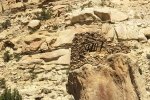
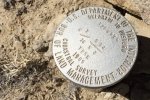
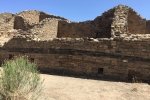
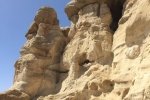

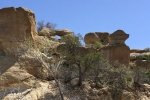

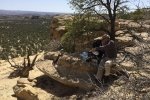
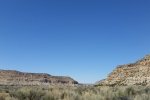


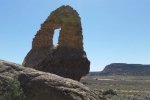
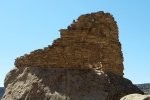

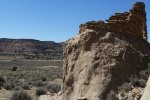




There are at least 450 arches in New Mexico. I have tracked down a bunch of them, ranging from maybe 30 feet high to about 3 inches high. No kidding! A 3 inch arch is underwhelming, but actually finding it was kind of cool.
The pueblito ruins on the boulder are really interesting. I wonder whether it was actually intended to be defensive or whether there was some other reason.